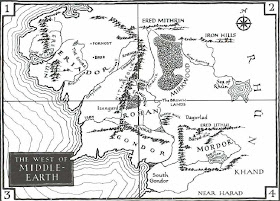Tolkien and Howard
In his biography of J.R.R. Tolkien, Daniel Grotta observes that "1936 appears to have been a turning point" in the author's life. Tolkien gave a well-received lecture on Beowulf that year. He also had The Hobbit, "his first full-length fairy story," accepted for publication. At age forty-four, Tolkien was on the cusp of a new career as a world-renowned author of fantasy. Nineteen thirty-six was also the year in which Robert E. Howard, creator of Conan, brought his own life to an end.
I could write all day about Tolkien and Howard. Lots of people already have. But I don't suppose I would have anything new to say. Instead I'll try to keep it short. The most obvious similarity between the two is in their creation of a world set in our own world's dim past, a world of adventure in which magic holds sway. I haven't seen any discussion of another similarity I have noticed, but the lack of discussion could be because there is nothing to discuss. I won't let that stop me though.
Robert E. Howard created Conan and his Hyborian Age in 1932 with a number of stories, background notes, and at least one map. The first Conan story, "The Phoenix on the Sword," was published in Weird Tales in December of that year. Howard went on to write many more tales of his dark and sullen barbarian before his death. Other writers followed with their own pastiches. In the fantasy revival of the 1960s, Conan became very popular and was of course adapted to the comics. That's where this map, based on Howard's original, comes from:
As you can see by the legend, the Hyborian Age took place in our own past, "circa 10,000 B.C." The continent over which Conan roams corresponds roughly with Europe, with a little bit of Asia and Africa thrown in as well. Conan is a Cimmerian. That's his country (in yellow) in the northern and western part of the continent. Robert E. Howard must have known a little about geography, but the layout of his countries and their features seems a little odd to me.
J.R.R. Tolkien began writing The Hobbit and its sequels in the 1930s. Like Howard before him, Tolkien developed a geography and history of his imaginary land. Bilbo Baggins liked maps. I suppose Tolkien did, too. In any case, here's one depiction of Middle-Earth (1):
Tolkien probably did not know anything about Howard or Conan or even Weird Tales when he began designing Middle-Earth. (2) There is some small resemblance between the two continents however. Both face to the west and a barrier sea. (3, 4) Both protrude into that sea on the north and suck themselves in on the south (leaving enough room for a legend in the lower left corner). Both also contain an inland sea on the east, the Vilayet Sea in Conan's world, the Sea of Rhûn in the Hobbits' world. There are several prominent rivers flowing from northeast to southwest on both maps. In the top map, the southernmost large river, the Styx, bends to the south. In the bottom map, its counterpart bends to the north and drains the middle part of the continent. I have the same feeling about this map as about Howard's. Artificial is the obvious word to describe it. A physical geographer would probably have a thing or two to say about both maps. Perhaps the two authors should have consulted with someone like Slartibartfast before proceeding. (5)
There's one more thing worth noting here: If you were to overlay one map on the other, you would see that Cimmeria and The Shire are roughly in the same position in their respective continents. Is that a coincidence? I'm not so sure. Howard and Tolkien (Lovecraft, too) favored northern and western lands and peoples over all others. You can't go too far north and west of course. Then you would be in the boondocks. But mostly north and mostly west work out pretty well and make a good native country for your hero.
Notes
(1) I don't know the source for this map, nor who drew it.
(2) According to L. Sprague de Camp, the bee in the bonnet of all Howard and Lovecraft fans, Tolkien did in fact read at least one Conan story, but that wasn't until the 1960s.
(3) What lay on the other side of that sea? Another continent of equal wonders?
(4) Both continents are also oriented in the same way the continent of Europe is oriented (or should I say "occidented"?).
(4) Both continents are also oriented in the same way the continent of Europe is oriented (or should I say "occidented"?).
(5) Here's an oddity for you: Blogger's spellchecker accepts Slartibartfast without a problem but puts a red line under Lovecraft.
Text copyright 2013, 2023 Terence E. Hanley


No comments:
Post a Comment